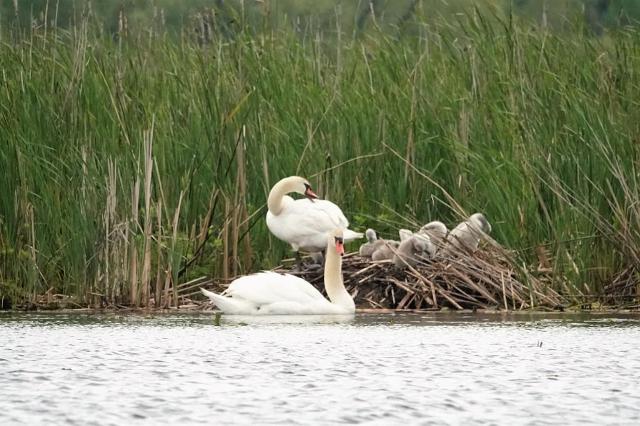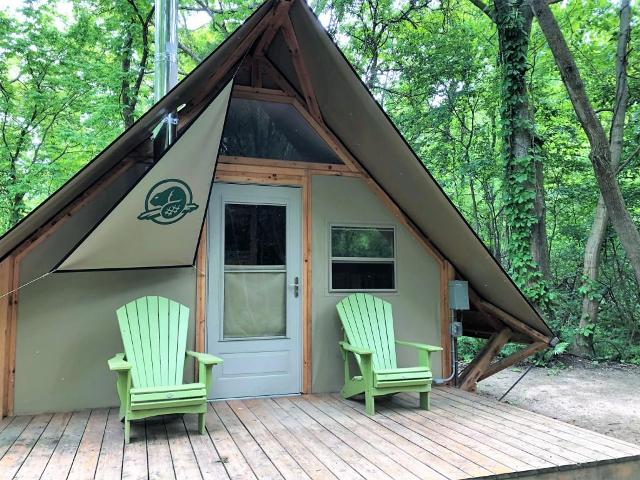GLAMPING, BIRDING, AND PADDLING
AT CANADA'S SOUTHERN TIP
By John Geary
As I approached the edge of the beach, I stopped for a few seconds to record a panoramic video of the vista in front me – mainly water. Then, into the lake I went. Or at least my toes did ... followed slowly by my feet, up to my ankles. That was it – I'd done it! I'd dipped my feet into Lake Erie at the southernmost point on Canada's mainland.
Just a three-hour drive from Toronto's Pearson International Airport, Point Pelee is part of the country's second smallest national park.
There is no vehicle access to that section of the park, other than a park-run shuttle than operates daily from mid-April until the end of October from the visitor centre. You can also walk the two-kilometre road or ride a bike. Only park vehicles are allowed access through the gates.

1 Tip of the point
Seeing that southernmost tip is one of the attractions of Point Pelee. (The absolute southernmost point of Canada is a little further out: Middle Island, a tiny island south of Pelee Island, accessed by a 90-minute ferry ride – but that's an adventure for another time!)
However, the main reason most people go there is for the birds. Look at any Top 10 list of places to bird-watch in Canada, it's always there, usually in the top two or three, if not Number 1.
The park contains trails of varying lengths which pass through several diverse habitats where you can spot a wide range of bird species – including the rare and endangered prothonotary warbler. Warblers abound in the park; during my visit there, I also spotted vultures, cardinals, blue jays, swallows, wrens, woodpeckers, and Baltimore orioles in the forests.

2 prothonotary warbler
There is also a boardwalk which winds through the marsh along the park's northeast corner; you can also paddle a canoe or kayak through the marsh into one or more of several ponds separated from the lake by a thin strand of beach. During an afternoon paddle there, my big highlight proved to be a pair of tundra swans sitting on their nest with this year's babies. I also encountered black terns, eastern kingbirds, red-winged blackbirds - and several turtles.

3. tundra swans on the nest
Before doing any birdwatching or hiking, a quick trip to the visitor centre may be in order. The staff can answer any questions you may have, and the displays provide info about the park and its history.
The park is also a great place to camp – especially if you want to camp comfortably. The park also offers 24 oTENTik sites for visitors to stay in, a better-than-tenting/not-quite-glamping option. Each site includes a gas barbecue, picnic table, fire ring, and food locker to keep all your food safe from animals like raccoons, squirrels and other small critters.

4 oTENTik
Keeping food and gear in vehicles is not really an option, because they're parked in a spot near the main road, and you shuttle your food and gear along a path past the washroom facilities (which provide flush toilets and showers) to your oTENTik site, using hand-pulled park-provided carts.
Camping away from a vehicle makes for a nicer ambiance, you feel a bit closer to nature…even more so when you awake in the morning to the sound of “gobble-gobble-gobble!” and walk outside to find a pair of wild turkeys wandering around the campsites!
While most overnight visitors cook their own food over a grill, camp stove or open fire, you will want to treat yourself to some fish and chips at the Birdie's Perch Bus-taurant just a few minutes outside the park. In a converted British two-decker bus, the cooks will dish up locally caught perch – hence the double entendre in its name – along with other dishes like burritos, tacos, and hot dogs. I'm glad I just got the three-piece cone of perch and chips, as the portion was more than enough to fill my belly. Of course, I wanted to leave some room for Kawartha Ice Cream, served up out of the tiny shack beside the bus kitchen.

5 Bus-taurant
Still, nothing beats meals cooked in the out-of-doors…and nothing beats sitting by a campfire as the sun sets, watching the stars come out, only to be overtaken by a full moon. A raccoon dropped by for a brief visit as I watched the embers die down, leaving a glowing bed of coals. As the furry masked would-be-raider melted back into the dark forest, I sighed a long, drawn-out breath, sad to think I was leaving the next day. But I can always come back for another visit…
IF YOU GO:
You can rent canoes through the Friends of Point Pelee. Be aware that if the wind is really strong, they may not rent you a canoe for safety purposes. http://friendsofpointpelee.com/
The Pelee Wings Nature Store also rents canoes and kayaks. You may also bring your canoe or kayak. http://www.peleewings.ca/
Parks Canada hosts interpretive programs for groups, taking them out into the marsh in large voyageur canoes. If you want to stay there in one of the oTENTiks, you can access the info at: https://www.pc.gc.ca/en/pn-np/on/pelee/activ/otentik
While in the area, if you want to enjoy further adventures on the water, you can also explore Pelee Island, but you need to book a ferry ride to make the 90-minute trip out into Lake Erie. You may also stay there overnight, as there are campgrounds there. http://www.ontarioferries.com/en/mv-jiimaan-mv-pelee-islander/
• The southernmost tip of mainland Canada: the “point” at Point Pelee, jutting into Lake Erie.
• The very rare and endangered prothonotary warbler. Point Pelee is one of the few places in Canada they nest.
• Tundra swans on the nest with this year's brood of young birds.
• Parks Canada oTENTiks: the ONLY way to camp!
Birdie's Perch: Enjoy some local fish and chips just outside the park